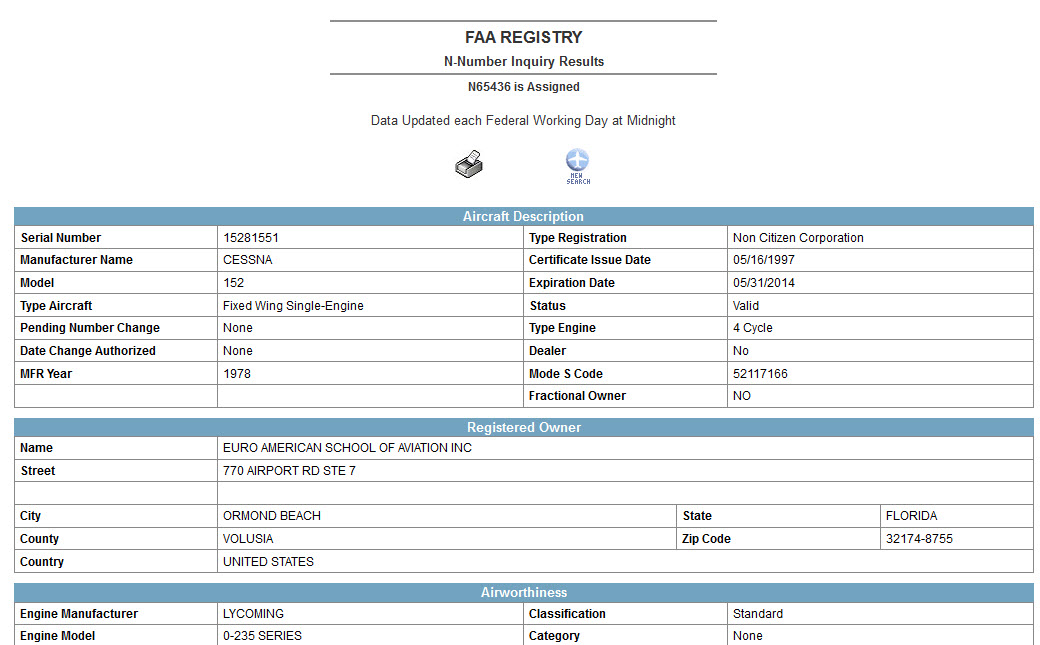
Summary of aviation incidents at Ormond Beach
Airport - from NTSB aviation incident databases:
Note: I gathered this information from doing internet searches and created the
below report..
Links used are listed at the end of the report
In 11 years, from 2001 to 2012, 15 incidents have occurred involving
Ormond Beach Airport and thirteen of the fifteen involved flight schools.
Several involved
Euro American School of Aviation (formerly Ormond Beach Aviation -which
changed names after several incidents) and Ormond Beach Aviation. This
does not include a 1999 incident mentioned below.
The NTSB and FAA are slow to conclude their reports and have delayed gathering
data. The 7/10/2011 crash, item 3, was not completed and posted online until April
2013, almost two years later.
1. 8-24-2012 - Sunrise Aviation - aircraft went off end of runway -
no injuries
2. 11-17-2011 - Private aircraft - bounced landing - 1 minor injury
3.
7-10-2011 - Euro American School of Aviation aircraft - student
pilot - aircraft crashed into trees (no fuel, read report)
2 serious injuries
4. 8-23-08 - Euro American School of Aviation aircraft - student pilot - 2
minor injuries
5. 8-19-2007 - LAFT Asset Management - Airplane was being used by Ormond
Beach Aviation
(which later became Euro American School of
Aviation) student pilot - 1 serious injury
6. 7-23-2007 - HRAD Group - Helicopter incident -
student pilot - 2 minor injuries
7. 10-21-2006 - Four Star Aero Services - student pilot - no injury
8. 5-16-2006 - Ormond Beach Aviation - student pilot - no injury
9. 11-15-2003 - Sunrise Aviation - student pilot - no injury
10. 5-23-1003 - Theibeaux Aviation - not student pilot related - no injury
11. 6-4-2002 - Euro American School of Aviation aircraft on current
registration, formerly Ormond Beach Aviation - student pilot - 2 minor injuries
12. 2-25-2002 - Euro American School of Aviation aircraft on current
registration, formerly Ormond Beach Aviation - student pilot - no injury
13. 9/5/2001 - Euro American School of Aviation
aircraft on current registration, formerly Ormond Beach Aviation - student pilot
- no injury
14. 7/21/2001 - registered to BCC Equipment
Leasing Corp. (at time of incident)
and operated by Embry-Riddle Aeronautical
University - student pilot - no injury
15. 4-9-2001 - registered to Boeing Capital, and
operated by Embry-Riddle Aeronautical University - student pilot - no injury
In addition, read at the end of the page about an incident July 24, 1999
involving Ormond Beach Aviation and the response to the FAA investigator.
1. 8-24-2012 - Sunrise Aviation - no
injuries -
2. 11-17-2011 - Private aircraft had a
bounced landing with one minor injury. The NTSB report does not indicate
training was involved.
3.
7-10-2011 - Euro American School of Aviation
aircraft - when you read the report it shows their was no fuel in the
tank or carburetor
PRELIMINARY REPORT THAT WAS ONLINE UNTIL APRIL 2013
(FINAL REPORT FOLLOWS):
NTSB Identification: ERA11LA393 ,
14 CFR Part 91: General Aviation,
Accident occurred Sunday, July 10, 2011 in Ormond
Beach, FL
Aircraft: PIPER PA-28-161, registration: N9202C,
Injuries: 2 Serious.
On July 10, 2011, about 1115 eastern daylight time, a Piper PA-28-161, N9202C, registered to the Euro American School of Aviation Inc (EASA)., was substantially damaged during a forced landing after a loss of engine power shortly after takeoff from the Ormond Beach Municipal Airport (OMN), Ormond Beach, Florida. The flight instructor and student pilot sustained serious injuries. The airplane was operated under the provisions of 14 Code of Federal Regulations Part 91 as an instructional flight. Visual meteorological conditions prevailed, and no flight plan was filed for the local flight that originated at 1030 from OMN.
FULL NARRATIVE ON ABOVE CRASH
On July 10, 2011, about 1115 eastern daylight time, a Piper PA-28-161,
N9202C, registered to the Euro American School of Aviation Inc (EASA)., was
substantially damaged during a forced landing after a loss of engine power
shortly after takeoff from the Ormond Beach Municipal Airport (OMN), Ormond
Beach, Florida. The flight instructor and student pilot sustained serious
injuries. The airplane was operated under the provisions of 14 Code of Federal
Regulations Part 91 as an instructional flight. Visual meteorological conditions
prevailed, and no flight plan was filed for the local flight that originated at
1030 from OMN.
The flight originated about 45 minutes prior to the accident from OMN, at which
time the flight instructor and student pilot flew in the local area to practice
flight maneuvers. The flight then returned to OMN to practice takeoffs and
landings on runway 26. After the flight's second takeoff, the Ormond Beach Tower
Control lost sight of the airplane. The airplane first collided with trees in a
wooded area approximately 150 feet beyond the departure end of runway 26. The
wreckage came to rest on the ground just south of the extended runway centerline
with its nose perpendicular to the centerline. The airplane sustained
substantial damage to the fuselage and wings.
In a written statement, the flight instructor reported that the flight was his
second of the day in N9202C. He stated that the student pilot was new to the
flight school and this was his first flight in the USA. The student had about 26
hours of previous flight training in the United Kingdom. During the preflight,
the instructor said that he verified the amount of fuel and talked about the
differences between the airplanes the student had previously flown and the
PA-28. The instructor reported that there was at least 12 gallons of 100LL fuel
per tank equaling a total of 24 gallons. He stated that based on his experience
with the aircraft, 24 gallons should have been sufficient for 3 hours of
training flight at a fuel consumption of 8 gallons per hour.
The instructor stated that since the flight was the student's first in the PA-28
and also his first in the USA, the startup process and taxi took longer than
usual. He said that it took a minimum of 0.2 hours until they were ready to go
through the power check checklist, which included switching fuel tanks. After
takeoff, the airplane was flown to a local practice area to perform routine
training maneuvers, then returned to the airport for touch and go practice
landings and takeoffs. The instructor performed the first touch and go to show
the student the procedures used at the flight school. On the second touch and go
takeoff which was flown by the student, the engine lost power after climbing to
about 200 feet AGL. The instructor took the flight controls and realized that
the airplane was too low to reach a safe landing area.
The instructor stated that about 40 minutes after the accident, a thunderstorm
passed through the area and contaminated the accident site.
The NTSB did not travel to the accident site. On site examination of the
airplane and engine was done by an FAA inspector, and his findings were relayed
to the NTSB during a telephone interview.
There was no indication or evidence that the propeller was being driven by power
prior to impact. Both fuel tanks were found compromised and void of fuel. A
visual inspection of the aircraft controls indicated that the primer knob was
stowed and the throttle was in the full forward position. The fuel selector knob
was found in the left tank position. The electric fuel pump was found in the
“ON” position, and the fuel mixture knob was found in a normal range for flight.
Inspection of the firewall mounted fuel filter screen revealed that it was clean
and free of obstruction. About one table spoon of fuel was detected in the
bottom of the fuel bowl. No fuel was found in the carburetor bowl and the
throttle linkage to the carburetor showed no signs of damage. When the
carburetor jet was activated, it operated normally. The main fuel line that
extended from the fuel tanks to the mechanical fuel pump was void of fuel when
it was disconnected from the pump at the fuel pump fitting. Activation of the
mechanical fuel pump lever indicated that the diaphragm was intact and
operational, with no signs of damage or binding. No fuel was detected in the
fuel pump bowl.
Removal of the valve covers, and rotation of the propeller forward and aft
resulted in the intake and exhaust valves opened and closed respectively. The
left magneto was removed from the engine and checked for a short to ground. The
unit showed no evidence of damage or internal failures. The right magneto could
not be removed for inspection.
A review of EASA flight logs indicated that on the day of the accident, the
airplane was flown on the first flight about 1.5 hours. The airplane crashed
about 1.2 hours into the second flight. The log also indicated that the airplane
was not refueled between flights. It was not possible to verify the aircraft
fuel system quantity prior to the first flight on the day of the accident.
However, a refueling slip for the airplane showed that the aircraft was last
refueled on the day prior to the accident with about 26 gallons. According to
the airplane's operating handbook, the total fuel capacity is 48 usable gallons
(26 gallons per tank). Daily flight records for the airplane indicated that
three different pilots flew the airplane for about 4.8 hours without evidence of
refueling before it crashed.
The instructor pilot stated that there was about 12 gallons of fuel in each wing
tank prior to the accident flight. According to performance charts in the
airplane's operating handbook, best economy mixture settings would burn about
8.5 gallons per gallons per hour (GPH) which translates to about 1.4 hours of
flight time for 12 gallons. The preflight ground checks of 0.2 hours and flight
time of 1.2 hours would equate to about 1.4 hours of fuel burn for the accident
flight. Both the instructor pilot and student pilot stated that the fuel
selector was in the right tank position throughout the flight and was not
switched to the left tank.
4: 8-23-08 - Euro American School of Aviation aircraft - student pilot - 2
minor injuries
The flight instructor and student pilot of the Cessna 152 found water in the fuel tanks during the preflight inspection. Large amounts of fuel had to be sumped to ensure all the water was removed. Their 1-hour instructional flight was uneventful. They returned to the departing airport, landed and took a short break from flying. They then returned to the airplane to continue the instructional training of touch-and-go landings. The fuel system was not sumped before the second flight. During the initial climb after the first touch-and-go, the engine lost all power about 300 feet above the ground. The flight instructor took over control of the airplane and landed on a golf course fairway, striking trees before coming to a stop. Postcrash examination revealed 6 ounces of water in the gascolator and the right fuel tank cap had indication of leaking and infiltration.
The National Transportation Safety Board determines the probable cause(s) of this accident as follows:
Both pilots' inadequate preflight inspection of the fuel.

5. 8-19-2007 - LAFT Asset Management - Airplane was
being used by Ormond Beach Aviation (which later became Euro American School of
Aviation)
On the morning of the accident, the student pilot and
the certificated flight instructor (CFI) flew to a local airport and back, and
then conducted several takeoffs and landings. After refueling, the CFI released
the student pilot for solo flight to continue practicing takeoffs and landings.
The student pilot took off approximately 1/2- hour after his previous taxi-out,
and in the intervening period, the wind had increased. The student pilot
performed a go-around from a landing to runway 08 following his first landing
attempt. According to air traffic control tower personnel, the student pilot's
second landing attempt was also unsuccessful, and the student pilot initiated a
second go-around. During the go-around, the airplane banked to the left,
descended, and impacted the grass approximately 600 feet north of the east-west
active runway. The airplane was substantially damaged and the student pilot was
seriously injured. A postaccident examination of the airplane did not reveal any
preimpact failures or malfunctions. Winds about the time of the accident were
from 070 degrees at 12 knots. All of the student pilot's flight time (27 total
hours) was in the Liberty XL-2 (25 hours dual and 2 hours solo). Subsequent to
the accident, the Federal Aviation Administration (FAA) released a “Fact Finding
Investigation Report” on the Liberty XL-2 airplane. The investigation was
initiated in response to a complaint from a flight school alleging safety
deficiencies, and not in response to this accident. The report concluded that
“the airplane controls are more sensitive to other training airplanes, but the
airplane meets 14 CFR part 23, subpart B [design certification] requirements and
is an acceptable airplane for training.” The report also stated that the FAA
“did not find any specific safety concerns that have not been addressed.”
(This report was modified on June 19, 2009)
The National Transportation Safety Board determines the probable cause(s) of this accident as follows:
The student pilot's failure to maintain aircraft control during an attempted go-around.
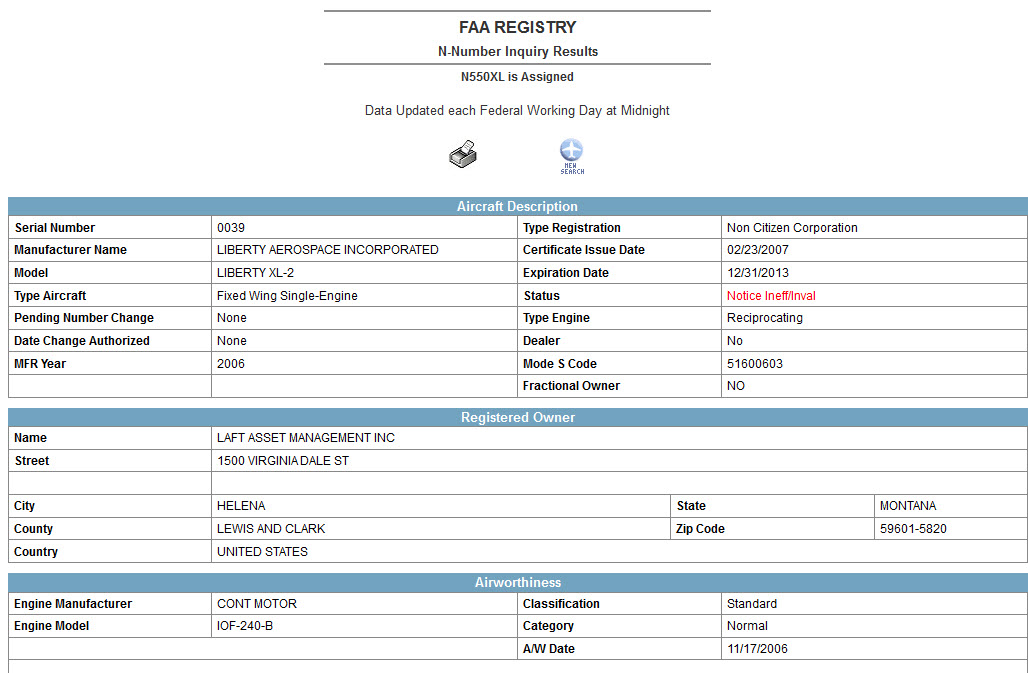
6. 7/23/2007 - HRAD Group - Helicopter incident -
student pilot
The certified flight instructor (CFI) and a student
pilot were practicing an engine failure, with a 180-degree turn. According to
the CFI, the student pilot attempted to "stretch," to reach a field to the
helicopter's left, even though a more obtainable field was located to the
helicopter's right. The CFI called for a go-around at 150 feet above the ground;
however, when the student pilot rolled on the throttle and pulled up on the
collective, the rpm began to drop quickly, and the helicopter continued to
descend. The CFI took the controls; however, the helicopter struck pine trees,
and descended to the ground. Examination of the helicopter did not reveal any
preimpact mechanical malfunctions.
The National Transportation Safety Board determines the probable cause(s) of this accident as follows:
The certified flight instructor's delayed remedial action, which resulted in an in-flight collision with trees.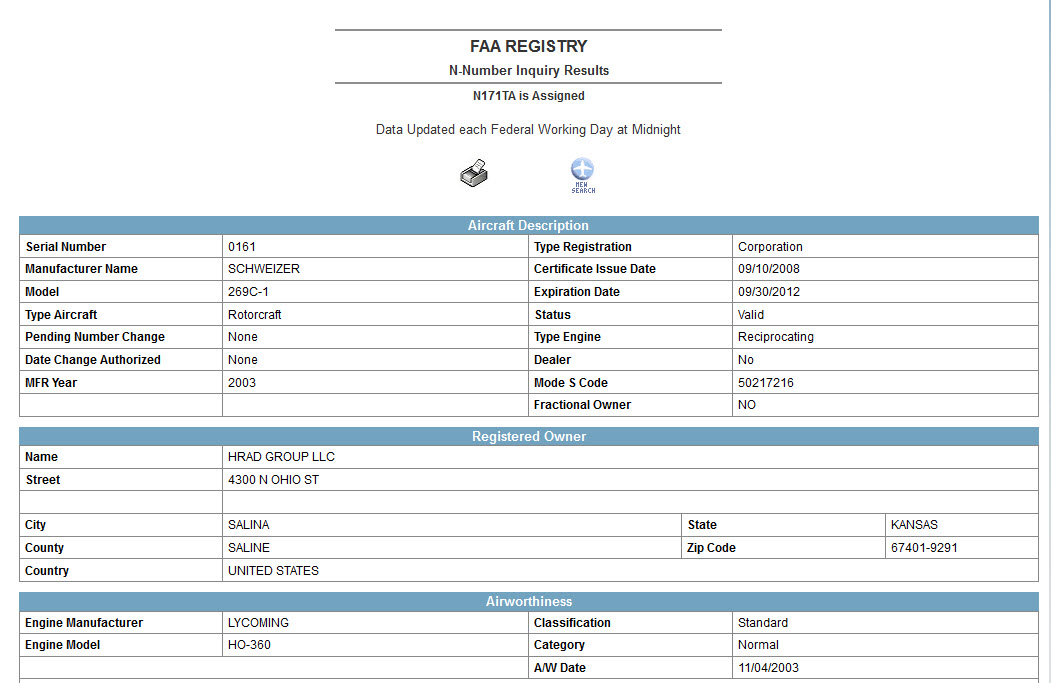
7. 10/21/2006 - Four Star Aero Services - student pilot
The pilot stated that the flight proceeded to the destination airport and was cleared by air traffic control to land on runway 8. The flight turned from the downwind leg onto base, then onto final approach and with 30-degrees of flaps extended, attempted to maintain 61 knots for the practice short field landing. She began to flare but felt the main landing gear wheels "skid against the pavement" and the airplane then became airborne. She maintained the aft elevator input and again felt the main landing gear wheels skid on the runway and the airplane became airborne again. After the third touchdown the airplane remained on the runway and she taxied to the ramp. According to the NTSB "Pilot/Operator Aircraft Accident/Incident Report" form, witness reported seeing a flat approach, contact with the runway, then the airplane porpoised. The recommendations section of the report indicates that a go-around should have been performed upon first indication of a faulty approach.
The National Transportation Safety Board determines the probable cause(s) of this accident as follows:
The failure of the student pilot to initiate a recovery from the bounced landing resulting in a hard landing.
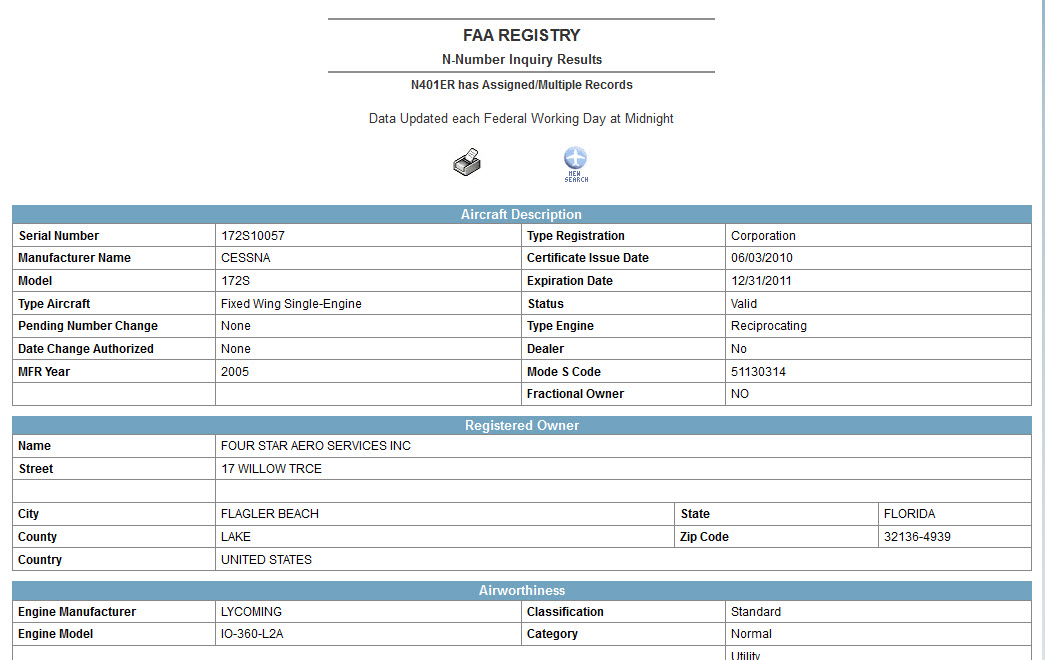
8. 5/16/2006 - Ormond Beach Aviation - student pilot
The airplane was flown by the student and certified flight instructor (CFI) on 2 separate flights lasting a total of approximately 2.8 hours. While taxiing after landing following the second flight, the CFI reportedly advised the student to fill the fuel tanks before flying solo in the traffic pattern. The student reported that while taxiing after landing following the second flight the CFI advised him after looking at the fuel gauges to supply fuel to the engine from the left tank because it had a greater amount of fuel. The airplane was not fueled before the student departed solo and during the initial climb to remain in the traffic pattern, the engine sputtered. The student decreased the angle of attack and engine power was restored; this sequence was reported as occurring 3 times by a witness located on the airport. After the engine lost power a third time, engine power was not restored and the airplane collided with trees, then the ground during a forced landing. Postaccident inspection revealed the fuel selector was found positioned to the left fuel tank which was empty, while the right fuel tank was approximately 1/2 full. The airplane was recovered without removal of the wings and transported to the airport where the engine was started and operated without discrepancies to 1,000 rpm. Concern for internal engine damage precluded operation at a higher rpm. Examination of the fuel gauges revealed that with electrical power applied, the left fuel gauge "pegged full." The left fuel transmitter and left fuel gauge independently tested satisfactory. Examination of the electrical wiring from the left fuel transmitter to the fuel gauge revealed a discrepancy with a connection near the wing root.
The National Transportation Safety Board determines the probable cause(s) of this accident as follows:
A loss of engine power due to the student pilot's improper positioning of the fuel selector during takeoff. A contributing factor was the pilot's failure to abort the takeoff.
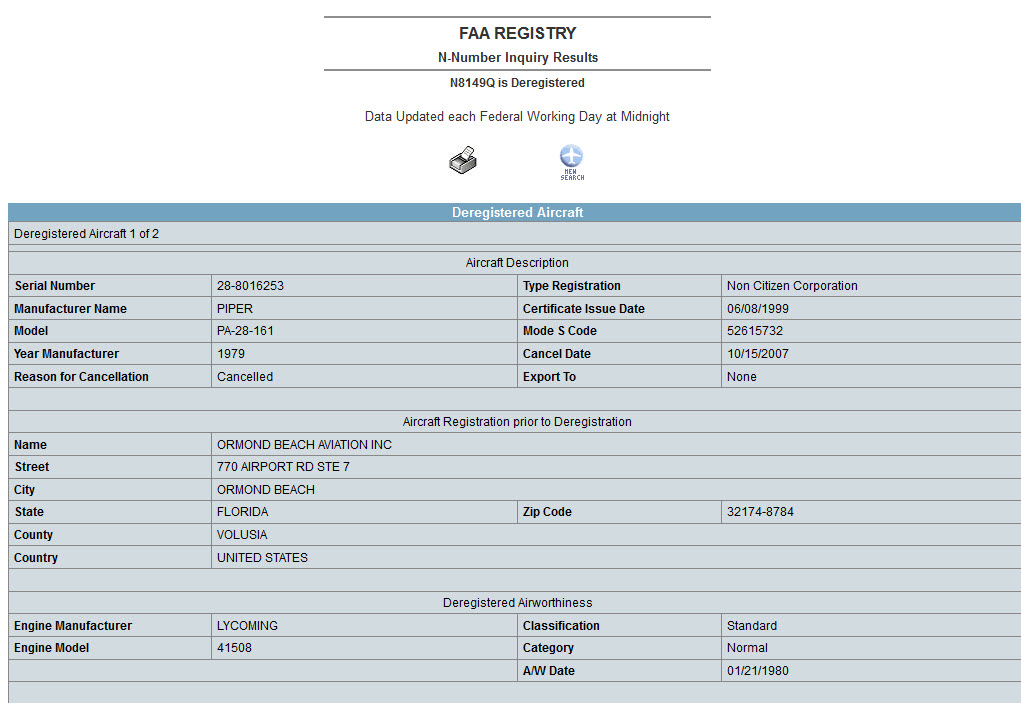
9. 11/15/2003 - Sunrise Aviation - student pilot
The student pilot stated that it was her first unsupervised solo and as she was executing the landing flare/touchdown, the airplane "porpoised", and she was unable to gain control. She said the nose gear collapsed, and the propeller contacted the runway, with the airplane incurring damage to the firewall. Prior to the accident, there were no mechanical failures or malfunctions to the airplane or any of its systems.
The National Transportation Safety Board determines the probable cause(s) of this accident as follows:
The student pilot improper recovery from a bounced landing, which resulted in a hard landing and damage to the airplane.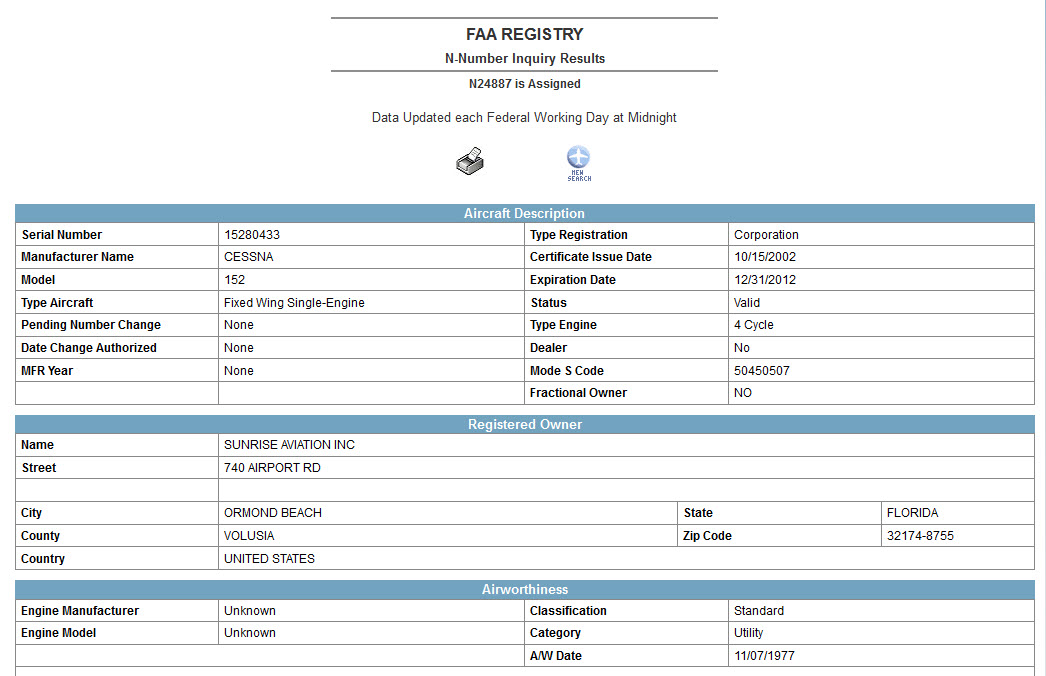
10. 5-23-03 - Theibeaux Aviation - not student pilot
related
The pilot stated that the planned trip duration was
between 2 hours 30 minutes and 2 hours 45 minutes. He originally planned to have
2 passengers on the flight but one of the passengers decided not to go. He and
his wife arrived at the airport and the owner of the facility that rented the
airplane to him asked him how much fuel was needed. A discussion with himself,
the owner of the renting facility, and a certified flight instructor was held
and it was agreed by all that a total of 40 gallons of fuel would be needed
which included fuel for reserve. At 1710, the operator placed a fuel order with
the only fuel facility on the airport. He performed his preflight inspection of
the airplane at about 1740 hours which included a visual check of the fuel level
in the fuel tanks. He estimated the total fuel capacity at the time of takeoff
was 30 gallons. The engine was started at 1745, and taxied to runway 06. The
flight departed and climbed to 7,500 feet where the flight proceeded direct to
the destination (Daytona Beach International Airport). When the flight was just
past Valdosta, he descended to 5,500 feet and remained at that altitude for a
few minutes then descended to 3,000 feet to maintain VFR conditions. The flight
continued and the pilot further stated that when over the St. Johns River just
west of St. Augustine, he descended to 1,500 feet to maintain VFR conditions.
When the flight was clear of weather he climbed to 2,500 feet and established
radio contact with Daytona Beach Approach Control. The controller "gave us the
go" for a left base to runway 7L at his destination airport when the flight was
7 miles away. At that time the engine lost power and he immediately switched to
the left tank. During the flight he had repositioned the fuel selector every 30
minutes. The engine was operating so he elected to divert to Ormond Beach. The
controller asked if there was a problem and he replied he needed to stop for
fuel. The controller gave him a frequency change to the Ormond Beach UNICOM
frequency, and there was no response to his radio calls. He turned close in on
the base leg and while on final approach, the engine "cut out...." The propeller
windmilled for a short time then stopped as the flight was clearing trees at the
approach end of the runway. The airplane was landed in grass short of the runway
resulting in collapse of the nose landing gear and subsequent nose over. He and
the passenger (his wife) exited the airplane and walked to the airport for
assistance. He further reported there was no mechanical failure or malfunction.
According to a sergeant with the Ormond Beach Police Department who is familiar
with aviation, the fuel tanks did not contain any fuel and there was no smell of
fuel at the accident site or in the cabin. According to an FAA inspector who
examined the airplane, both fuel gauges indicated empty with electrical power
applied, and both fuel tanks were empty. The fuel selector was found positioned
to the left fuel tank. No fuel was found in the gascolator. Examination of all
engine controls and flight controls revealed no evidence of preimpact failure or
malfunction. Examination of the propeller revealed 1 propeller blade was bent
slightly at the tip. Damage to the airframe precluded an engine run. Examination
of the engine revealed crankshaft and valve train continuity; no engine
discrepancies were reported. According to the operator of the airplane, the
airplane was last fueled on May 22, 2003, which brought the fuel level to the
bottom of the tabs in each fuel tank (15 gallons a side). The engine was then
operated for 24 minutes while on the ground; no flight was performed. He checked
the fuel level in both fuel tanks earlier in the day of the accident date and
reported that the fuel level in the left tank was below the bottom of the tab
and the fuel level in the right fuel tank was at the bottom of the tab. He was
aware that the accident pilot intended on flying the airplane and he asked the
pilot how much fuel was needed for the trip. The reply was both sides to the
slot which would give 20 gallons a side. He called the order in at 1710 hours.
According to the fuel facility located on the airport, the fuel request was made
but the flight departed before the airplane was fueled. Records provided by the
owner indicate that at the time of the accident, the airplane had been operated
for 2.7 hours since engine start. According to the Pilot's Operating Handbook
and FAA Approved Airplane Flight Manual, when fuel touches the bottom of the tab
it indicates 15 gallons of fuel, of which 13.7 gallons are usable.
The National Transportation Safety Board determines the probable cause(s) of this accident as follows:
The pilot's inadequate preflight and his failure to refuel the airplane before departure resulting in the total loss of engine power due to fuel exhaustion and a hard landing during the subsequent forced landing.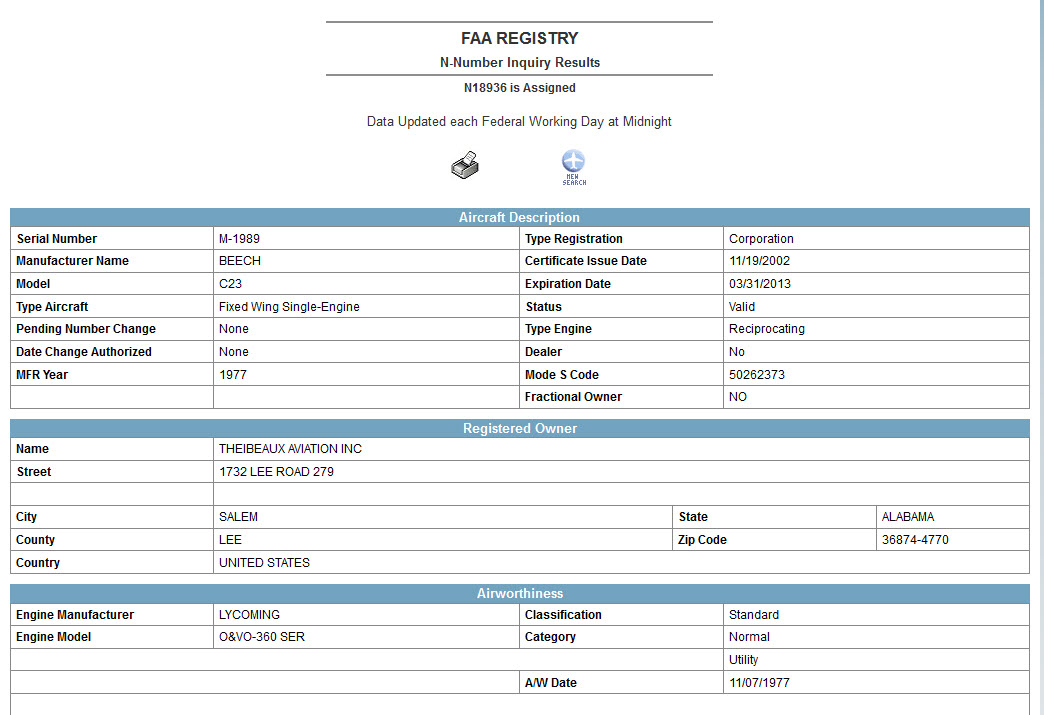
11. 6-4-2002 - Euro American School of Aviation aircraft on current registration, formerly Ormond Beach Aviation - student pilot
The flight instructor stated that the takeoff and initial climb were
uneventful, with the engine developing full power, and that during the climb the
student pitched up excessively, and the airspeed decayed to near the stall
speed. He said he then took control of the aircraft to avert a departure stall,
and tried to clear trees at the end of the runway, steering the aircraft toward
an area of lower trees, and extending the flaps to forty degrees in an attempt
to balloon over the trees, but the left main landing gear became entangled in a
tree, and the aircraft crashed incurring substantial damage. An FAA Inspector
conducted a postaccident examination of the aircraft and stated that he did not
find evidence of any preaccident failures or malfunctions to the aircraft or any
of its systems which would have caused the accident.
The National Transportation Safety Board determines the probable cause(s) of
this accident as follows:
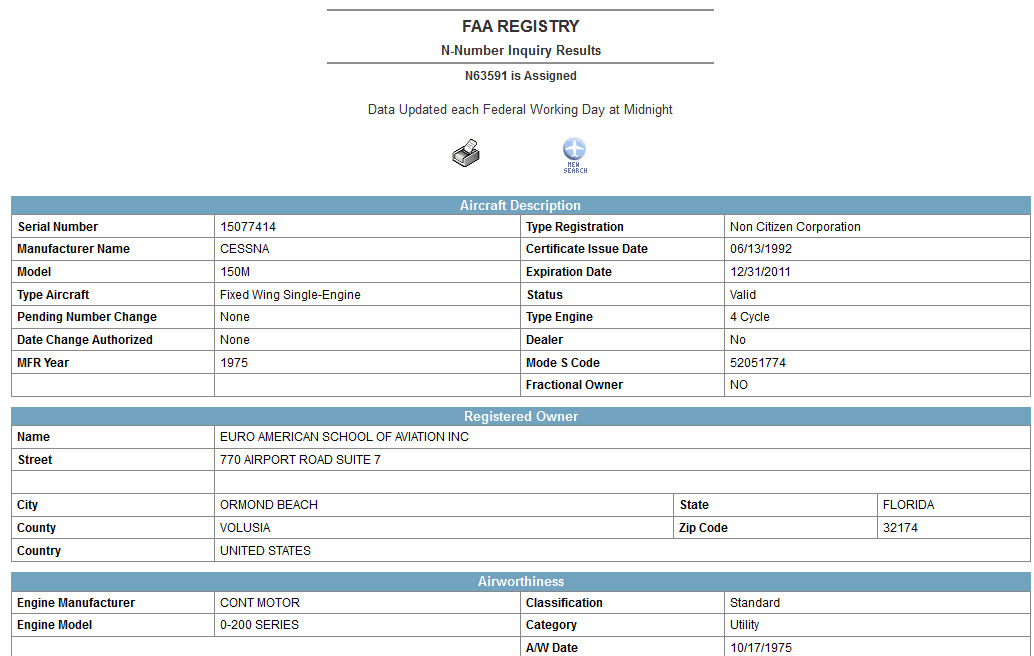
12. 2-25-2002 - Euro American School of Aviation aircraft on current registration, formerly Ormond Beach Aviation - student pilot
The student pilot entered the traffic pattern for landing. The pilot flared too high, bounced, and did not add power in an attempt to recover from the bounced landing resulting in the collapse of the nose gear. The student pilot had recorded as logged 8.5 total hours as pilot-in-command.
The National Transportation Safety Board determines the probable cause(s) of this accident as follows:
The student pilot's improper flare and failure to recover from a bounced landing resulting in the subsequent collapse of the nose gear during the landing flare touchdown. A factor contributing to the accident was the student pilot's lack of total experience.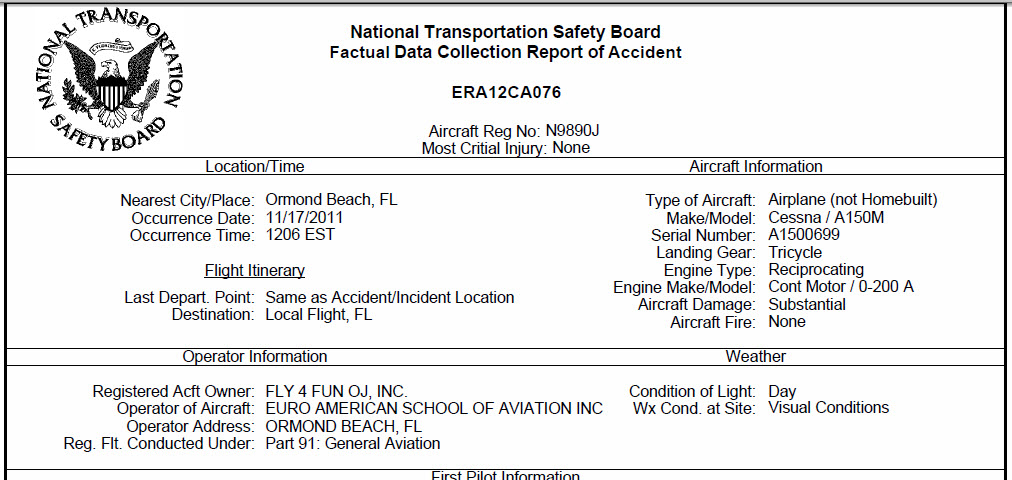
13. 9/5/2001 - Euro American School of Aviation
aircraft on current registration, formerly Ormond Beach Aviation - student pilot
The National Transportation Safety Board determines the probable cause(s) of this accident as follows:
the student pilot's improper landing flare/touchdown while attempting to make a soft field landing during a supervised solo flight which resulted in substantial damage to the aircraft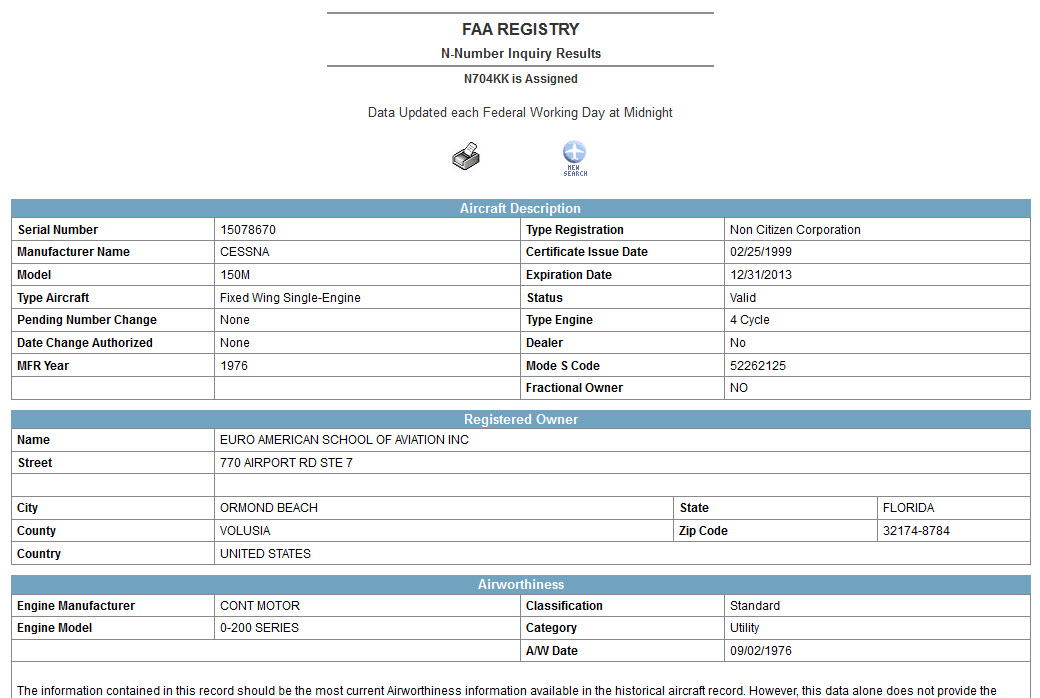
14. 7/21/2001 - registered
to BCC Equipment Leasing Corp. (at time of incident) and operated by
Embry-Riddle Aeronautical University - student pilot
During the student pilots first solo flight, and on the
third landing, the airplane bounced on the runway, nose wheel first. The student
reported a wind from the left, followed by a horizontal wind shift into a
crosswind from the right. According to the student pilot, she overcompensated
for the change in wind direction, distracting her from the landing and resulting
in a late flare. The student cited "inexperience" as a factor in her hard
landing. The student pilot did not report a mechanical problem with the
airplane.
The National Transportation Safety Board determines the probable cause(s) of this accident as follows:
The student pilots improper flare, and improper recovery from a bounced landing. A factor was the student pilot's lack of total experience.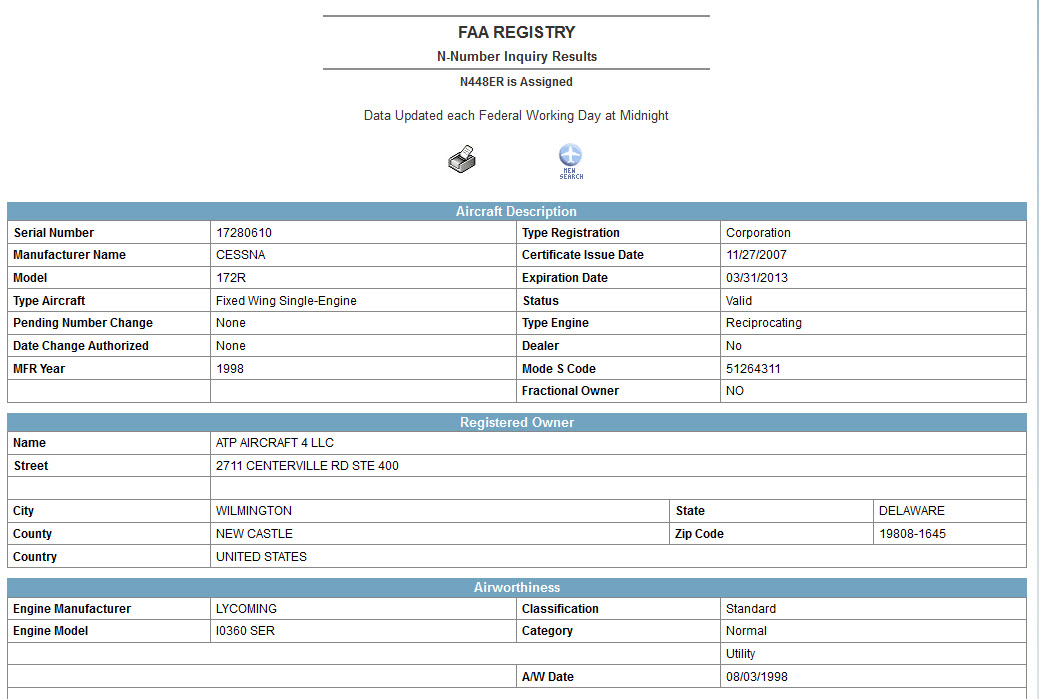
15. 4-9-2001 - registered
to Boeing Capital, and operated by Embry-Riddle Aeronautical University -
student pilot
The student said he had some difficulty with the traffic pattern and that during the landing as he started reducing power and initiating the flare, it seemed like it was a high flare, and they hit the runway hard. He said the instructor told him to go around, so he gave the airplane full power and tried to liftoff, but he "blew to the left, and headed off the runway." The instructor stated that she immediately told the student to go around, but as he added power, the airplane headed hard to the left, and did not liftoff. She said she yelled "my controls" but the left wing hit the wind sock. She said she did not know what caused the airplane to turn so severely, and further stated that she taught the student "CRAMB, CLIMB, CLEAN, COMUNICATE," when executing go-arounds, and the "CLEAN" part of the sequence had not been performed, since the climb had not been established. She said that full flaps were still down, and had been down before, during, and after the event. The instructor said that the student has large feet and she had warned him several times about making sure they were far enough back on the floor so that he would not hit the brakes accidentally. A functional check of the aircraft did not identify any preaccident failure or malfunction to the aircraft or any if its systems. The information handbook for the Cessna 172R, Section 4 specifies that the wing flaps must be retracted to 20 degrees immediately after the application of full throttle while executing balked landings.
The National Transportation Safety Board determines the probable cause(s) of this accident as follows:
the flight instructor's inadequate supervision and the dual student's improper use of brakes which resulted in the loss of directional control and collision with a wind sock. Contributing to the accident was the flight instructor's failure to follow procedures/directives.While the above was kept within a 11 year period,
2001 to 2012 I felt one more incident
should be added to this list...read my highlighted (in red) notes in the
narrative portion:
Date of incident: July 24, 1999
Aircraft involved: Ormond Beach Aviation
On July 24, 1999, about 0325 eastern daylight time, a
Cessna 150L, N19222, registered to Ormond Beach Aviation
Inc., was substantially damaged during a
forced landing, near Ormond Beach, Florida. The commercial-rated pilot and dual
student pilot reported serious injuries. Visual
meteorological conditions (VMC) prevailed in the vicinity, and no flight plan
had been filed. The local instructional flight was being conducted in accordance
with Title 14 CFR Part 91. The flight had originated from the Ormond Beach
Airport, at an unknown time.
The flight was conducted as an instructional flight for the purpose of giving
the student a night check-out. At 0324, a "MAYDAY"
call was made by one of the pilots to Daytona Airport. The flight
had been flying in the traffic pattern at Ormond
Beach, when the airplane's engine lost power. The
pilot put the airplane down on a road adjacent to the Ormond Beach Mall about
1/2 mile southwest of the airport. The airplane impacted the ground and nosed
over. Examination of the wreckage revealed that fuel was present in the fuel
tanks.
The engine was examined under the supervision of the FAA at Ormond Beach
Aviation's facility, Ormond Beach, Florida, on July 28, 1999. The examination
revealed that the No. 2 exhaust valve was stuck in the open position. According
to the FAA inspector's statement, "...the No. 2 exhaust valve was stuck open
which led to a loss of power." Further examination of the cylinder revealed no
discrepancies were found in the valve stem, valve guide size, or part numbers.
Toxicological tests were conducted on both pilots at the Federal Aviation
Administration, Research Laboratory, Oklahoma City, Oklahoma, and revealed, "No
ethanol or drugs detected in Blood."
Neither crewmember gave their version of the accident
or made any statements. The FAA inspector stated, "the flight instructor
suffered a head injury and could not remember the accident. The student [pilot]
refused to speak with the FAA and returned to England a few days after the
accident."
--------------------------
LINKS USED FOR DATA COLLECTION:
NTSB:
Incident database inquiry page:
http://www.ntsb.gov/aviationquery/index.aspx
FAA:
N number inquiry:
http://registry.faa.gov/aircraftinquiry/NNum_Inquiry.aspx
Note: This summary is subject to possible typographic errors
but to the best of my knowledge, it is all correct. If any corrections need to
be made they will be done as soon as I am notified.